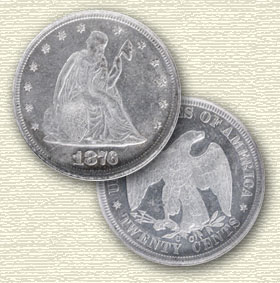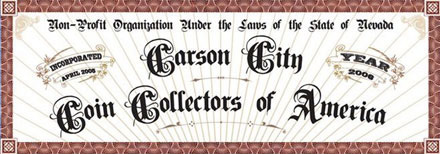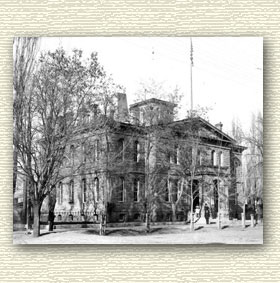- Posts: 614
- Thank you received: 0
1878-CC Seated 10c CC Coin of the Week 5-30-10
Less
More
15 years 5 months ago - 15 years 3 months ago #1192
by Garryn
1878-CC Seated 10c CC Coin of the Week 5-30-10 was created by Garryn
I was looking over the Coin of the Week spreadsheet that Belay Off has been maintaining for us and I noticed it is starting to look like a Jeopardy game board. I have been expending a lot of energy here on Morgan Dollars. So in the spirit of Jeopardy let’s do something different this week. Let’s take Carson City Dimes for 1878.
There were 20.9 million dimes minted at Carson City during its short life and all of those were squeezed into 9 years, 1871 through 1878. In the last year the census recorded only 200,000 dimes. Yet this is the third highest mintage. In the early years. 1871 through 1874, mintages did not top 31,200 in any year.
Rusty Goe, in his epic, The Mint on Carson Street, estimates only 300 to 500 survive in all grades; only 65 to 80 of which are in mint state. Similar fates befell the 1878-CC quarters and half dollars. Rusty Goe tracked surviving populations of 900 and 120, respectively, on the high side of his estimation. Ownership of a specimen of any of these minor silver coins is a treasure to any Carson City Mint enthusiast.
There are 4 known reverse dies. On our blog, on November 2, 2009, an anonymous poster responded to a question and described both dies. There is one Type 1 die, “the E of ONE is close to the wreath, whereas on TII the E is distant. That's the attribution many use. However, ... look at the end of the left ribbon below the bow. On TI, it's split or bifurcated; on TII, it's pointed.” The Type 1 die is also known as the Reverse of 1877. There were three Type 2 dies used in 1878.
Dr. Michael Fey, contributing to the Winter 2007 issue of Curry’s Chronicle, in his article Insights into GSA "CC" Silver Dollars compared the value of an 1889-CC silver dollar in mint state with about 1,600 certified specimens, to an 1878-CC dime in mint state with only about 80 known specimens. He noted that a low end mint state 1889-CC would set a buyer back about $22,000 and a similar mint state 1878-CC dime would change hands at about $1,200. Dr. Fey said he became so enamored with the dime, after reading C4OA member Gary Baker's article Carson City Sleepers in the Fall 2006 issue of Curry's Chronicle, that he aquired a mint state example of the shattered reverse variety.
There are two recorded MS68s, one each seen at NGC and PCGS. There are two MS67s, both graded by NGC. In November 2002, Bowers and Merena sold an MS67 at auction for $5,635. Since then two other gem pieces have crossed the block, an MS66 and most recently an NGC MS65 in July 2009, for $3,635.
This is a splendid example of a Type 2 reverse die, from the Gerry Fortin Collection. PCGS MS64. Enjoy and be well. I hope everyone had a safe and restful Memorial Day holiday.
There were 20.9 million dimes minted at Carson City during its short life and all of those were squeezed into 9 years, 1871 through 1878. In the last year the census recorded only 200,000 dimes. Yet this is the third highest mintage. In the early years. 1871 through 1874, mintages did not top 31,200 in any year.
Rusty Goe, in his epic, The Mint on Carson Street, estimates only 300 to 500 survive in all grades; only 65 to 80 of which are in mint state. Similar fates befell the 1878-CC quarters and half dollars. Rusty Goe tracked surviving populations of 900 and 120, respectively, on the high side of his estimation. Ownership of a specimen of any of these minor silver coins is a treasure to any Carson City Mint enthusiast.
There are 4 known reverse dies. On our blog, on November 2, 2009, an anonymous poster responded to a question and described both dies. There is one Type 1 die, “the E of ONE is close to the wreath, whereas on TII the E is distant. That's the attribution many use. However, ... look at the end of the left ribbon below the bow. On TI, it's split or bifurcated; on TII, it's pointed.” The Type 1 die is also known as the Reverse of 1877. There were three Type 2 dies used in 1878.
Dr. Michael Fey, contributing to the Winter 2007 issue of Curry’s Chronicle, in his article Insights into GSA "CC" Silver Dollars compared the value of an 1889-CC silver dollar in mint state with about 1,600 certified specimens, to an 1878-CC dime in mint state with only about 80 known specimens. He noted that a low end mint state 1889-CC would set a buyer back about $22,000 and a similar mint state 1878-CC dime would change hands at about $1,200. Dr. Fey said he became so enamored with the dime, after reading C4OA member Gary Baker's article Carson City Sleepers in the Fall 2006 issue of Curry's Chronicle, that he aquired a mint state example of the shattered reverse variety.
There are two recorded MS68s, one each seen at NGC and PCGS. There are two MS67s, both graded by NGC. In November 2002, Bowers and Merena sold an MS67 at auction for $5,635. Since then two other gem pieces have crossed the block, an MS66 and most recently an NGC MS65 in July 2009, for $3,635.
This is a splendid example of a Type 2 reverse die, from the Gerry Fortin Collection. PCGS MS64. Enjoy and be well. I hope everyone had a safe and restful Memorial Day holiday.
Last edit: 15 years 3 months ago by Garryn.
Please Log in to join the conversation.
- coindrummer
-

- Offline
- Platinum Member
-

- Michael D. Parrott
Less
More
- Posts: 775
- Thank you received: 0
15 years 4 months ago #1208
by coindrummer
C4OA Lifer!
Replied by coindrummer on topic Re:1878-CC Seated 10c CC Coin of the Week 5-30-10
You have provided us with a very informative article here on this final dime issue from the Carson mint. Indeed that is a splendid example courtesy of Jerry Fortin.
Michael the drummer
Michael the drummer
C4OA Lifer!
Please Log in to join the conversation.
Time to create page: 0.124 seconds



